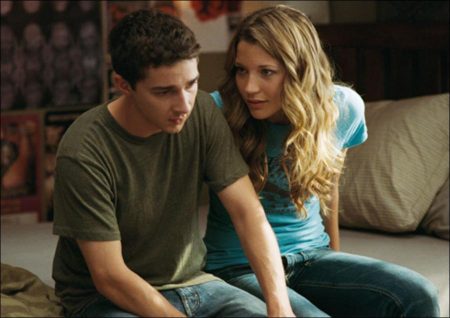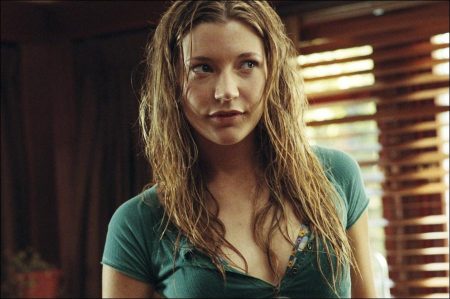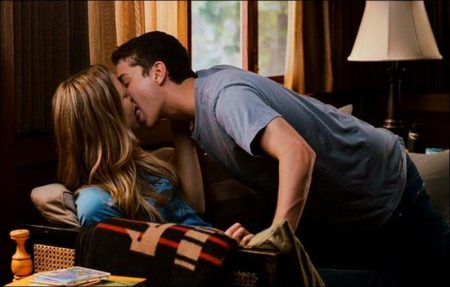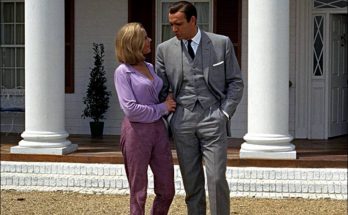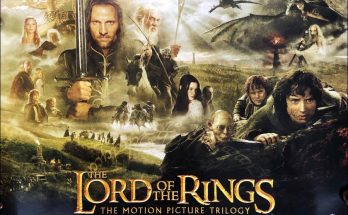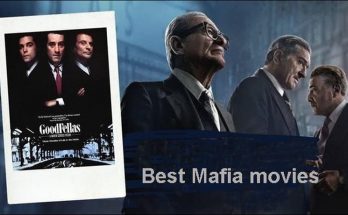Disturbia: Every killer lives next door to someone. After his father’s death, Kale (Shia LaBeouf) becomes sullen, withdrawn, and troubled – so much so that he finds himself under a court-ordered sentence of house arrest. His mother, Julie (Carrie-Anne Moss), works night and day to support herself and her son, only to be met with indifference and lethargy.
The walls of his house begin to close in on Kale. He becomes a voyeur as his interests turn outside the windows of his suburban home towards those of his neighbors, one of which Kale begins to suspect is a serial killer. But, are his suspicions merely the product of cabin fever and his overactive imagination?
A Trip to Disturbia
For writer Christopher Landon, the genesis for “Disturbia,” a suspense thriller in which the upscale homes and manicured lawns of suburbia could be the perfect hiding place for a serial killer, arose from a visit to his sister’s “Disturbia” Production Information home “deep in the ‘burbs of Los Angeles’ San Fernando Valley.
“Everyone pretty much considers suburbia as something that is idealistic and beautiful… but it’s always kind of given me the creeps,” Landon says. “One night, as I was driving home from my sister’s place, this idea just popped into my head – a story about a kid who is stuck in his house and begins to notice bizarre things happening across the way. He eventually comes to suspect that his neighbor is a serial killer.”
For Landon, the seeming calm of suburbia produces a “forest for the trees” effect, in which people go about their lives oblivious to the circumstances — benevolent or dangerous — surrounding them. “I think that many people who live in these neighborhoods fall into a daily routine and, for the most part, don’t really know their neighbors very well.”
Such is the case with Kale, the 17-year-old at the center of “Disturbia.” Until the automobile accident that killed his father, life with his family was the typical suburban dream. They were a happy, nuclear unit, ensconced in a beautiful two-story Craftsman bungalow. In the year since his father’s death, however, that dream had disintegrated. When the troubled Kale is challenged at school by one of his teachers, he lashes out, punches the instructor and winds up in court. While he is spared juvenile detention, Kale is sentenced to house arrest and must wear an ankle bracelet that will summon the police if he ventures more than 100 feet from his front door.
The upside of having the house to himself all day long quickly wear thin and Kale turns his attention to his next- door neighbors. He and his best friend Ronnie engage in a game of “I spy,” making note of the comings and goings of the residents around them. Curious patterns emerge and the glossy suburban façade begins to tarnish. Idiosyncrasies come to light and personal affairs are revealed. When Kale’s new neighbor, the beautiful Ashley, discovers his little game, she decides to join in on the spying.
But they soon make an unsettling discovery that turns the whole game deadly serious. “In general, we don’t really pay close attention to what’s around us, because we’re too busy with our lives,” observes Landon. “But Kale is now in a position where he really has nothing else to do but notice. And once he starts watching, he begins to see some unsettling things and he has to wonder if it’s just his imagination running wild, or is there more out there than meets the eye?”
For the screenwriter, one of the more compelling aspects of this kind of thriller was not the “is he or isn’t he a serial killer?” angle, but the personalities of the ragtag troupe of spying teenagers who are at the heart of the story. “In these types of films, you usually have someone like a Harrison Ford-type chasing down the bad guys. But these kids are not your classic hero types,” Landon notes. “Kale’s just this kid with time on his hands who realizes ‘I have an entire reality TV show happening all around me.’ In the process, he stumbles on a really dark and terrifying character in the show.”
It was exactly Landon’s voyeuristic exploration combined with a varied stylistic tone that ranged from almost comic to nail-biting that appealed to Montecito Picture Company producer Joe Medjuck. “All films are essentially voyeuristic in some way,”
Medjuk suggests. “But there are some great ones that are actually about people observing, looking at things. There’s Antonioni’s ‘Blow Up,’ Michael Powell’s ‘Peeping Tom,’ Hitchcock‘s ‘Rear Window,’ Coppola’s ‘The Conversation,’ along with several others. They’re about someone who’s looking at something, sometimes with a camera, sometimes not. And it’s fascinating, because it makes us especially aware that we’re always voyeurs when we’re in the cinema.
It’s an even stronger sensation when you have the point-of-view of someone who is spying on someone else. Kale’s looking at the girl next-door swimming and spying on the guy behind him because he thinks the guy might be a killer. He’s discovering things about the neighbors he probably shouldn’t know. And when people are not aware they’re being watched, they do things differently — behave differently — and that’s fascinating.”
Thanks to constant advances in contemporary electronic technology, it’s become increasingly easy to watch other people — stealthier surveillance equipment like DV is augmented with the ever-present camera cell phone –all of which allow Kale access to what’s going on beyond his restricted 100-foot perimeter from the “control center” inside his home.
For blockbuster filmmakers and Montecito Picture Company principals Ivan Reitman and Tom Pollock (who serve as executive producers on the film), “Disturbia” was somewhat of a conscious stylistic departure. “Most of the films we’ve produced have been broad comedies, usually with teenagers, or at least people behaving like teenagers, at the center, films such as ‘Old School’ and ‘Road Trip,’” Reitman mentions. “While this one has high school students as its main characters, it is a thriller…with some attitude. So it’s a little bit different.”
Adds Pollock: “We immediately recognized the story’s potential when we first read the script. What makes Kale and his friends interesting is the fact that we recognize them, and they wouldn’t normally be considered your typical heroes. This kid’s under house arrest, his best friend is a little eccentric, and his potential girlfriend is a misunderstood beauty. Set them down in the center of a thriller and we, as audience members, have someone to go along with.”
For director D.J. Caruso, while “Disturbia” could not really be considered a career departure (among his previous credits are the Angelina Jolie/Ethan Hawke thriller “Taking Lives”), it speaks to a different audience than his previous films. Caruso says, “My movies have tended to be a little bit more focused on characters with addictions or problems…or, in one case, fighting a serial killer. So this film presented a challenge — I grew up loving thrillers as well as films by people like Cameron Crowe and John Hughes. ‘Disturbia’ has elements of both those kinds of films, and these are avenues I hadn’t been able to previously explore as a filmmaker.”
It didn’t hurt that one of the entertainment industry’s giants had personally phoned him about the project. “I was directing the season premiere of ‘The Shield,’ and my phone rang…and it was Steven Spielberg,” says Caruso. “He said he had a script he wanted me to read that he thought I’d be perfect for. I read it as soon as I got it and came in and met with him. That’s how it all started, though I have to admit, for a minute there I thought it was a friend playing a practical joke.”
Caruso’s multifaceted career was one of his greatest strengths, according to producer E. Bennett Walsh, who found that his experience wearing other hats came in handy on “Disturbia.” “D.J.’s a great partner. He’s always thinking of what’s best for the story, and how to maximize it in front of the lens,” he says. “Because he has also been a producer, he has the skill set to know what it takes to get a show together while also being true to the creative elements. He makes sure that every shot he builds is the best shot. And when you think of what a film is —basically one shot after another to tell a believable story when we’re shooting, that’s exactly what we’re doing…building one block after another.”
Related Link: View the Full Production Notes for Disturbia
Views: 129
